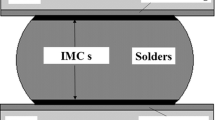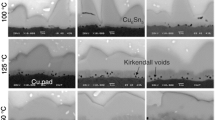Abstract
The step-soldering approach is being employed in the multi-chip module technology. High-lead-containing alloys are among the solders currently being used in this approach. Au-Sn and Au-Ge based candidate alloys have been proposed as alternative solders for this application. In this work, a corrosion investigation was carried out on potential ternary lead-free candidate alloys based on these binary alloys for high-temperature applications. These promising ternary candidate alloys were determined by the CALPHAD approach based on the solidification criterion and the nature of the phases predicted in the bulk solder. This work reveals that the Au-Sn-based candidate alloys close to the eutectic composition (20 wt.% Sn) are more corrosion resistant than the Au-Ge-based ones.
Similar content being viewed by others
References
O. Ogunseitan, JOM, 59(7) (2007), pp. 12–17.
COST ACTION MP0602, Memorandum of Understanding for the Implementation of a European Concerted Research Action, “Advanced Solder Materials for High-Temperature Application,” Brussels (5 December 2006).
V. Chidambaram, J. Hald, and J. Hattel, “Development of High Melting Point, Environmentally Friendly Solders, Using the CALPHAD Approach” (Presentation at 2008 TOFA Conf., Krakow, Poland, 22–27 June 2008).
Morten S. Jellesen et al., “Corrosion in Electronics” (Paper presented at 2008 Eurocorr Conference, Edinburgh, Scotland, 7–11 September 2008).
R. Baboian, “Electronics,” Corrosion Tests and Standards: Applications and Interpretation, ed. R. Baboian (West Conshohocken, PA: ASTM, 1996), www.corrosionsource.com/events/intercorr/baboian.htm.
A.T. Dindale et al., “COST 531 Database V 3.0” (Wien, Germany: Universität Wien, June 2008), www.univie.ac.at/cost531/.
Scientific Group Thermodata Europe, “SSUB3-Substance Database V 3.2,” (2001/2002/2004), www.sgte.org/.
Rene Bergmann et al., “In-situ Investigation of Lead-Free Solder Alloy Formation Using a Hot-Plate Microscope” (Presentation at 2007 Electronics Packaging Technology Conf., Singapore, 9–12 December 2007).
Rajan Ambat, “Localized Corrosion Information Using High Resolution Measurement Devices” (Presentation at 2005 Eurocorr Conference, Lisbon, Portugal, 8–9 September 2005).
Rajan Ambat and Per Møller, J. Corros. Sci., 49(7) (2007), pp. 2866–2879.
Vivek Chidambaram, John Hald, and Jesper Hattel, J. Microelectron. Electron. Pack., submitted.
Vivek Chidambaram, John Hald, and Jesper Hattel, J. Microelectron. Reliab., 49(3) (2009), pp. 323–330.
P.J. Martin, W.B. Johnson, and B.A. Miksic, “Corrosion Inhibition of Electronic Metals Using Vapor Phase Inhibitors” (Presentation at 1984 National Association of Corrosion Engineers Meeting, New Orleans, LA, 2–6 April 1984).
Mulugeta Abtew and Guna Selvaduray, J. Mater. Sci. Eng., 27(5–6) (2000), pp. 95–141.
C. Andersson and J. Liu, J. Fatigue, 30(5) (2008), pp. 917–930.
Barry L. Rudman, “A Comparison of Several Corrosion Inhibiting Papers in Various Environments” (Presentation at 1998 National Association of Corrosion Engineers Meeting, San Diego, CA, March 1998).
Author information
Authors and Affiliations
Corresponding author
Rights and permissions
About this article
Cite this article
Chidambaram, V., Hald, J., Ambat, R. et al. A corrosion investigation of solder candidates for high-temperature applications. JOM 61, 59–65 (2009). https://doi.org/10.1007/s11837-009-0089-4
Published:
Issue Date:
DOI: https://doi.org/10.1007/s11837-009-0089-4




